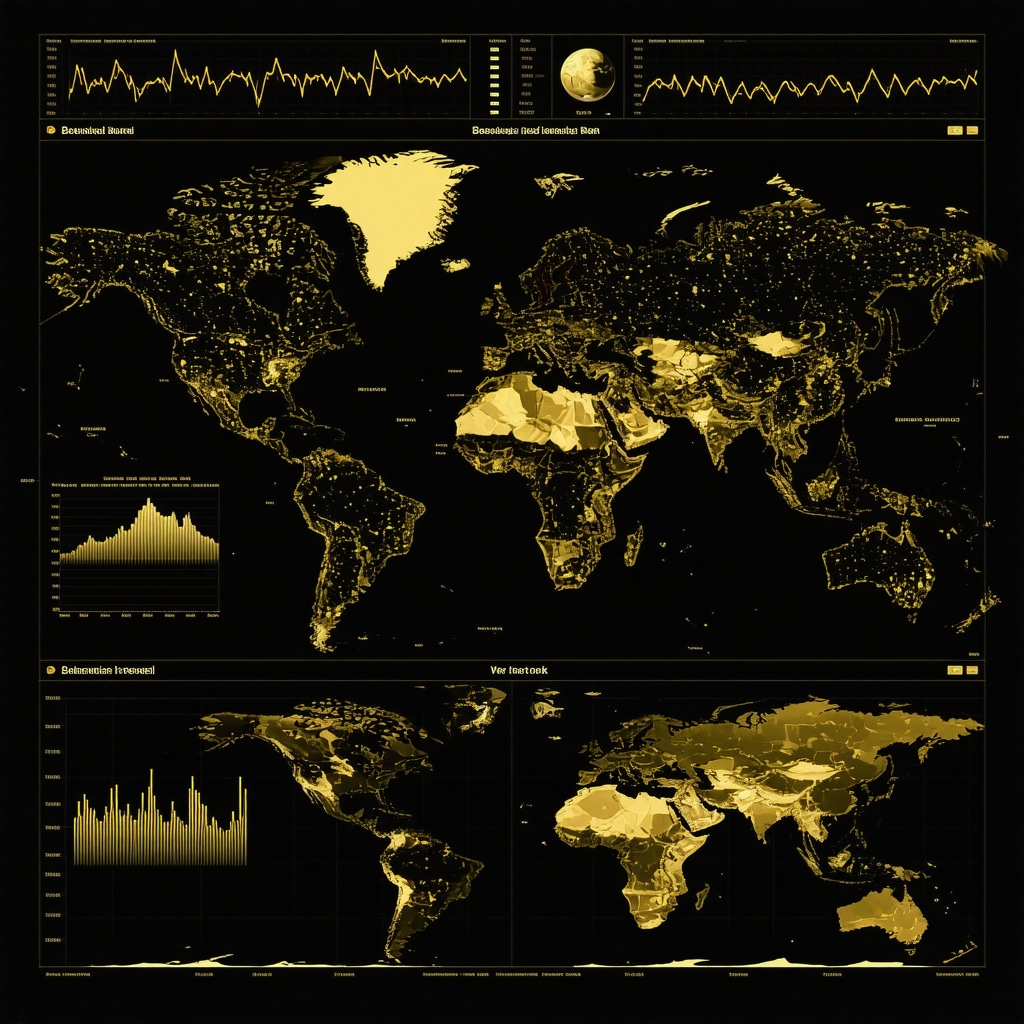Gold: The Shimmering Tug-of-War Between Supply and Demand
Imagine the world of gold investing as a grand theater where supply and demand waltz in an ever-changing rhythm, orchestrating the price movements that keep investors on their toes. It’s a drama that’s been unfolding for centuries, yet every act brings new intrigue. From the dusty mines of South Africa to the gleaming vaults of central banks, the story of gold is as much about human behavior as it is about geology.
Why Should You Care About Gold Supply and Demand Dynamics?
Let’s cut to the chase: if you’re dipping your toes into gold investing, understanding the push and pull of supply and demand isn’t just academic—it’s your secret weapon. Gold isn’t like your average commodity; its supply can’t be ramped up overnight, and demand swings wildly with economic moods, cultural trends, and geopolitical jitters. This unique interplay means savvy investors who grasp these dynamics can anticipate price shifts better than most.
Could a Shortage or Surplus in Gold Actually Make or Break Your Portfolio?
Here’s a thought to chew on: Gold mining output tends to be fairly steady but limited by the planet’s finite resources and mining challenges. Meanwhile, demand can spike unexpectedly—think jewelry surges during festive seasons or increased buying from central banks aiming to diversify reserves. When demand outpaces supply, prices soar; when the opposite happens, prices cool off. So, the question is, how do you spot these market tremors before they ripple through your investments?
Not All Gold Is Created Equal: The Many Faces of Demand
Gold’s allure isn’t just in bars and coins. The tech sector, for instance, gobbles up gold for its conductivity and resistance to corrosion, while investors see it as a hedge against inflation and currency devaluation. Central banks, too, play a starring role—they can shift the market significantly with their buying or selling decisions. According to the World Gold Council, central banks purchased over 600 tonnes of gold in recent years, underscoring their influence on global demand (source).
When Supply Chains Snag and Demand Dances Wildly
Mining isn’t immune to disruptions—think labor strikes, regulatory hurdles, or environmental challenges. These bottlenecks can tighten supply unexpectedly. Meanwhile, demand can be just as mercurial, swayed by inflation fears or shifting consumer preferences. The 2020 pandemic, for example, led to a surge in gold demand as investors scrambled for safety nets amid economic uncertainty.
Want to dive deeper into how these forces shape the gold market and what it means for your investment choices? Check out the insightful breakdown on gold supply and demand insights for smart investors. It’s a treasure trove of knowledge for anyone serious about navigating this glittering market.
So, Are You Ready to Decode the Gold Market’s Secrets?
Understanding the rhythms of gold supply and demand is no mere hobby—it’s the difference between guessing and knowing, between reacting and strategizing. For investors, this means better timing, smarter portfolio choices, and ultimately, the potential for more robust returns. So next time you glance at the glittering metal, remember: behind the shine lies a complex dance that’s shaping your financial future.
Have thoughts or experiences with gold investing? Share your stories below—let’s unravel this golden puzzle together.
Global Events: The Invisible Hand Guiding Gold’s Supply and Demand
Gold’s market dynamics do not exist in a vacuum. Instead, they are deeply intertwined with global geopolitical shifts, economic policies, and unexpected crises that ripple across international borders. For instance, trade tensions between major economies can lead to increased uncertainty, pushing investors toward gold as a safe haven, thereby driving up demand. Conversely, diplomatic resolutions or economic recoveries may cool enthusiasm for gold, tempering prices.
Supply is similarly affected. Political instability in gold-producing regions can disrupt mining operations or logistics, leading to temporary shortages that reverberate through the market. Understanding these external catalysts and their nuanced impacts can help investors anticipate market moves rather than merely reacting.
Technological Innovations and Sustainable Mining: Shaping Future Supply
While gold mining has traditionally been a resource-intensive and environmentally challenging industry, recent technological advancements are beginning to reshape this landscape. Automation, improved extraction methods, and environmental regulations are influencing production costs and output levels. Moreover, sustainable mining initiatives are gaining traction, as consumers and investors demand greener practices. These shifts could constrain supply or increase costs, ultimately affecting gold’s price trajectory.
How Will Emerging Technologies and Sustainability Trends Reconfigure Gold Supply Dynamics?
This question invites investors to consider the long-term implications of evolving mining technologies and environmental stewardship. Could these factors tighten supply sufficiently to spur price appreciation? Or will they create new efficiencies that stabilize output and prices? Staying informed on these developments is crucial for crafting a forward-looking gold investment strategy.
For a comprehensive view of how gold supply and demand trends are evolving amid global economic shifts, consider exploring the detailed analysis by the World Gold Council, a leading authority renowned for its rigorous research and market insights (World Gold Council – Gold Demand Trends).
Integrating Gold Into a Diversified Portfolio: Strategies for 2025 and Beyond
Given the complexities of gold’s supply and demand dynamics, how should investors position themselves? Diversification remains a cornerstone principle. Allocating assets across physical gold, ETFs, mining stocks, and futures can balance risks and opportunities. For instance, physical gold offers direct exposure and inflation hedge, while mining stocks may provide leveraged returns but come with operational risks.
To deepen your understanding and discover practical approaches, check out our resource on how to build a balanced gold portfolio with ETFs and stocks. This guide covers the nuances of asset selection tailored for 2025 market conditions.
Do you have insights or questions about integrating gold into your investment strategy? Share your thoughts or strategies in the comments below to contribute to a vibrant community dialogue and collective learning.
Decoding the Impact of Monetary Policy Shifts on Gold Demand Volatility
Monetary policies enacted by central banks worldwide wield profound influence over gold demand—a reality that seasoned investors cannot afford to overlook. When interest rates rise, traditional fixed-income assets become more attractive, often drawing capital away from gold, which does not yield interest. Conversely, dovish monetary stances, such as quantitative easing or rate cuts, tend to ignite gold’s appeal as an inflation hedge and store of value amid currency debasement fears.
The nuanced interplay between real interest rates and gold prices is a sophisticated dance that requires investors to monitor central bank communications and macroeconomic indicators closely. For example, the Federal Reserve’s policy shifts in response to inflationary pressures directly affect gold’s opportunity cost and thus its demand among institutional and retail investors alike.
How Do Changing Real Interest Rates Specifically Influence Gold Investment Strategies?
Understanding the sensitivity of gold prices to real interest rates is essential for constructing robust portfolios. When real rates are negative or low, gold’s non-yielding attribute becomes less of a disadvantage, enhancing its attractiveness. Investors may increase allocations to physical gold or gold-backed ETFs during such periods. Conversely, rising real rates often prompt a strategic reallocation toward yield-bearing assets, signaling potential short-term declines in gold demand.
According to a detailed analysis by the International Monetary Fund (IMF Working Paper on Gold Prices and Monetary Policy), the correlation between gold prices and real interest rates underscores the metal’s role as a hedge during expansive monetary environments.
Unmasking the Role of Behavioral Economics in Gold Demand Fluctuations
Beyond fundamentals, behavioral economics offers a compelling lens through which to interpret gold’s demand volatility. Investor psychology, herd behavior, and sentiment-driven market swings can amplify gold’s price movements beyond what supply-demand metrics alone might predict. For instance, during geopolitical crises or financial market turbulence, fear and uncertainty drive a surge in gold purchases, often triggering feedback loops that push prices higher.
This psychological dimension adds layers of complexity for investors seeking to time gold market entries and exits. Recognizing signals such as shifts in market sentiment indices, volume spikes in gold-related assets, and social media trends can provide early warnings of impending demand surges or contractions.
Leveraging Advanced Analytics and AI to Anticipate Gold Market Trends
In today’s data-rich environment, harnessing advanced analytics and artificial intelligence (AI) tools is becoming indispensable for decoding the intricate gold market dynamics. Machine learning models can process vast quantities of economic data, social sentiment, geopolitical developments, and supply chain disruptions to generate predictive insights on gold price trajectories.
These technologies enable investors to move beyond reactive strategies toward anticipatory positioning, enhancing risk-adjusted returns. For example, AI-driven sentiment analysis can detect subtle shifts in investor mood or geopolitical tensions before they fully manifest in market prices, offering a competitive edge.
Exploring platforms like Bloomberg Terminal or specialized AI-based commodity analytics services can empower investors with these cutting-edge capabilities.
Strategic Timing: When to Adjust Gold Exposure Amid Fluctuating Supply Constraints
Mining supply disruptions—whether from regulatory changes, environmental activism, or operational setbacks—can tighten gold availability and spark price spikes. Yet, responding effectively requires distinguishing between transient bottlenecks and structural supply shifts.
Advanced investors employ scenario analysis and supply chain mapping to evaluate the duration and impact of these constraints. For instance, prolonged mine closures due to permitting issues may justify increasing physical gold holdings or gold mining equities, whereas short-lived labor strikes might call for cautious, temporary positioning.
Integrating these nuanced assessments into portfolio management can optimize returns and mitigate downside risks amid volatile supply conditions.
Psychology Meets Precious Metals: How Behavioral Economics Fuels Gold’s Demand Surges
Gold’s shimmering allure extends beyond tangible supply-demand mechanics into the realm of human psychology. Behavioral economics reveals that emotions such as fear, greed, and herd mentality can dramatically amplify gold’s price swings. When financial markets tremble or geopolitical tensions escalate, investors often flock to gold as a psychological safe haven, creating self-reinforcing demand spikes that defy pure fundamentals.
Consider how sentiment-driven buying during crises triggers feedback loops—rising prices lure more buyers, elevating demand further. This dynamic complicates timing entry and exit points, urging investors to monitor sentiment indices, social media chatter, and trading volumes closely to anticipate these waves. For those ready to decode these psychological cues, the payoff can be substantial.
Can Integrating Behavioral Insights with Traditional Analysis Enhance Gold Investment Outcomes?
Absolutely. Combining behavioral data with fundamental and technical analysis offers a multidimensional perspective, helping investors avoid emotional pitfalls and capitalize on market moods before they peak. The Journal of Behavioral Finance highlights that sentiment-driven gold demand often precedes macroeconomic shifts, providing a leading indicator for savvy portfolio adjustments (source).
Artificial Intelligence: The New Oracle of Gold Market Forecasting
The gold market’s complexity demands cutting-edge tools, and AI-powered analytics are transforming how investors forecast price movements. By ingesting diverse datasets—ranging from mining output reports and central bank purchases to geopolitical news and social sentiment—machine learning algorithms detect nuanced patterns invisible to traditional analysis.
Platforms utilizing AI can deliver predictive signals on supply disruptions or demand surges well ahead of market consensus, empowering investors to position themselves proactively. Embracing these technologies is no longer optional but essential for maintaining a competitive edge in 2025’s fast-evolving landscape.
Strategic Timing: Navigating Supply Shocks and Demand Swells with Precision
Supply-side disruptions—like regulatory clampdowns or environmental protests—may cause temporary gold shortages that ripple through prices. But discerning whether these constraints are fleeting or structural is crucial. Advanced investors deploy scenario planning and real-time data tracking to differentiate between short-term noise and long-term trends.
For example, a protracted mine closure due to permitting issues might justify increasing allocations in physical gold or mining equities. Conversely, transient labor strikes may call for tactical, short-duration exposure. This nuanced timing strategy can maximize gains while mitigating downside risks amid volatile supply conditions.
To deepen your strategic approach, explore 2025 Gold Price Forecast: What Investors Need to Know Now for expert analysis on timing and market drivers.
Fostering a Dialogue: Your Perspectives on Behavioral and Technological Shifts in Gold Investing
How have psychological factors or AI-driven insights influenced your gold investment decisions? Are you leveraging sentiment analytics or scenario planning to anticipate market moves? Share your experiences and strategies below—your insights could illuminate paths for fellow investors navigating the golden labyrinth.
For a comprehensive dive into gold demand trends shaping 2025, don’t miss our detailed coverage at Gold Demand Trends 2025: What Investors Must Monitor.

Expert Insights & Advanced Considerations
Behavioral Economics as a Leading Indicator in Gold Demand
Investor psychology often precedes shifts in gold demand beyond traditional supply-demand metrics. Recognizing sentiment-driven buying patterns during geopolitical or economic crises can provide anticipatory signals that enhance timing and allocation strategies. Integrating behavioral data with fundamental analysis offers a more nuanced approach to navigating gold’s volatility.
Technological Innovation and Environmental Policies Reshape Future Gold Supply
Advancements in mining technology coupled with stricter environmental regulations are redefining production costs and outputs. Sustainable mining initiatives may constrain supply or increase operational expenses, potentially leading to upward price pressure. Staying abreast of these evolving factors is essential for forecasting gold market trends and adjusting investment approaches accordingly.
The Impact of Real Interest Rates on Gold’s Opportunity Cost
Gold’s appeal fluctuates inversely with real interest rates. When real rates are low or negative, gold’s non-yielding nature becomes less of a disadvantage, boosting demand as an inflation hedge. Conversely, rising real rates tend to divert capital toward yield-bearing assets, tempering gold’s attractiveness. Monitoring central bank policies and inflation expectations is critical for dynamic portfolio positioning.
AI and Advanced Analytics Empower Proactive Market Positioning
Leveraging AI-driven sentiment analysis, supply chain monitoring, and geopolitical data parsing offers investors a competitive edge. These technologies can detect subtle market shifts ahead of traditional indicators, allowing for timely adjustments in exposure to physical gold, mining equities, or derivatives. Embracing such tools is increasingly indispensable in 2025’s complex gold market landscape.
Strategic Timing Requires Differentiating Between Transient and Structural Supply Shocks
Not all supply disruptions are equal; discerning between short-term bottlenecks and long-term structural changes is crucial. Scenario analysis and real-time data tracking can inform whether to increase physical holdings, invest in mining stocks, or adopt a cautious stance. This precision timing optimizes returns while mitigating risk amid fluctuating supply constraints.
Curated Expert Resources
- World Gold Council – Gold Demand Trends: Offers comprehensive, data-driven insights into evolving global gold demand, essential for understanding underlying market forces. (gold.org)
- IMF Working Paper on Gold Prices and Monetary Policy: Explores the nuanced relationship between monetary policy shifts, real interest rates, and gold prices, providing a macroeconomic framework for investment decisions. (imf.org)
- Buying Gold Now – 2025 Gold Price Forecast: What Investors Need to Know Now: Delivers expert analysis on timing and market drivers tailored for 2025, helping investors anticipate and react to key supply-demand developments. (buyingoldnow.com)
- Buying Gold Now – How to Build a Balanced Gold Portfolio with ETFs and Stocks: Provides strategic guidance on diversification and asset allocation within gold investments, critical for risk management and growth. (buyingoldnow.com)
- Journal of Behavioral Finance: Offers scholarly insights into how investor sentiment and herd behavior influence gold market dynamics, beneficial for integrating behavioral economics into strategy. (tandfonline.com)
Final Expert Perspective
Decoding gold supply and demand dynamics demands a multifaceted lens that blends traditional fundamentals with behavioral insights and cutting-edge technology. In 2025, investors must navigate a complex interplay of real interest rates, supply chain innovations, environmental considerations, and psychological drivers to craft resilient strategies. Understanding these advanced nuances transforms gold from a mere commodity into a dynamic portfolio cornerstone. Engage deeply with these evolving factors and explore our expert resources like 2025 Gold Price Forecast and balanced portfolio strategies to sharpen your investment acumen. Share your seasoned perspectives or questions below—let’s elevate the discourse around gold investing together.










